
December 30, 2014
 CR Holiday Interview #1—Jesse Jacobs
CR Holiday Interview #1—Jesse Jacobs


*****
Jesse Jacobs'
Safari Honeymoon was one of the big, pleasurable surprises of the first half of 2014. It was visually impressive, grounded in memorable character work and extremely funny. I wanted to revisit the book at the end of the year because of comics' tendency to pick only a few comics to stay in a year's mental summing-up from spring over summer and into the fall. I also next to nothing about Jacobs, who strikes me as a cartoonist working in a world created by alt-comics expression rather than following a concurrent path to the cartoonists of a generation ago. I was extremely happy he agreed to interview, and look forward to all future works. I edited a tiny bit for flow. -- Tom Spurgeon
*****
TOM SPURGEON: Jesse, I know almost nothing about you. The Koyama Press bio says you were born in Moncton, which strikes me as a regional hub -- a small city, kind of isolated. Is there a lot of that place in your art, in how you approach art?
JESSE JACOBS: I've never really thought of it like that, but I don't think there's much of Moncton in my art. Maybe there is, it's hard for me to say how much of anything has influenced the way I make things. There wasn't a whole lot going on in Moncton, so I drew a lot growing up. As soon I finished high school I moved to
Halifax, Nova Scotia, where I met a lot of interesting artists and was introduced to a lot of the stuff that got me into comics. I should say that Moncton does have some interesting stuff happening, especially in the francophone scene.
SPURGEON: Are there foundational artists for you, or core works that shaped your attitude about reading and making comics? Were there artists or comics that hit you hard? What about outside of comics, in the arts more generally?
JACOBS: Soon after moving to Halifax I started going to a great comics shop called
Strange Adventures, which stocked all sorts of interesting books. I remember finding stuff like
Archer Prewitt's Sof' Boy and
Julie Doucet books and something inside of me kind of changed. They had Chester Brown come and give a talk at the library and I was so into his work. The local arts and culture paper,
The Coast, was running
Marc Bell's comics around that time. All these comics were introduced to me within a few weeks and I was inspired.
I was discovering all these wonderful comics during my first year of art school, so I was simultaneously being exposed to fine artists that deeply impacted me. A teacher of mine, when they saw what kind of stuff I was drawing, showed me Ray Johnson and I watched the documentary
How to Draw a Bunny. That film blew me away. I've always gravitated towards fine artists who make work that reminds me of weird comics...
Philip Guston,
George Grosz,
Tiger Tateishi,
Ray Yoshida,
Jim Nutt,
Pedro Friedeberg.
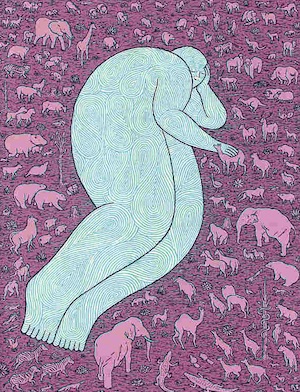 SPURGEON: Were you trained as an artist? Your works seems refined and exact to the point where I'm guessing you received some training -- plus there are elements of art school critique in By This Shall You Know Him. At the same time, you also seem very self-directed. How much of your skill set is due to some formal training and how much have you developed on your own?
SPURGEON: Were you trained as an artist? Your works seems refined and exact to the point where I'm guessing you received some training -- plus there are elements of art school critique in By This Shall You Know Him. At the same time, you also seem very self-directed. How much of your skill set is due to some formal training and how much have you developed on your own?
JACOBS: I studied fine arts at
the Nova Scotia College of Art and Design. I was immature, and I didn't get as much out of it as I could have. I'm from a middle class family, and the idea of me not undertaking some form of post-secondary education was not even close to a possibility. I just wanted to draw weird doodles and go skateboarding so art school seemed like my best bet. [Spurgeon laughs]
I met a lot of close friends, which is the best thing to come out of the experience. I learned a lot about printmaking and design. I studied a lot of film history, which has directly informed my work. I'm glad I went but in retrospect I probably should have taken a few years after high school to grow a little. Art school, in my experience, has a lot to do with how much you want to put into it. It's kind of easy to coast.
SPURGEON: What was the first impulse to start making self-published comic? What got you from simply making things on paper or in your notebook to publishing them in a way you want others to see them?
JACOBS: Even as a kid I was really into making copies of my drawings. My dad had a Xerox machine at his office and I used to play with it. In high school I made a lot of zines with a friend. In art school I found a group of people who were into making comics and we published our own anthologies. I've always wanted people to see my work, so photocopying drawings was the easiest way to get people to look at them. Ultimately, I make artwork because it's a very enjoyable process to me, but it's nice if others find enjoyment in it as well.
SPURGEON: Do you remember the first time you received feedback on your published work? Was there anything particularly memorable about that, something that might even have surprised you at the time, the way people were reacting?
JACOBS: Not in particular. I think I remember the negative feedback more distinctly. It's always painful when people react negatively to stuff I make. The toughest criticism -- and most helpful -- is when someone points out a flaw that I knew was there, but was too lazy to deal with. I try to focus on the feedback that makes me feel good, but even if a hundred people say nice things the one negative comment is the one that I remember.
SPURGEON: You won a pair of honors for your minis work: the Gene Day prize from the Shusters, followed quickly by recognition at the Doug Wrights. What do you remember about getting those awards now? Do you feel like they were helpful in terms of putting your work in front of more people?
JACOBS: There was a sense of validation. Canada seems to have a very supportive comics community, especially considering how small this country is. I'm sure there were some people who discovered my comics through those awards. The Shusters are great because they gave me money.
SPURGEON: [laughs] That is great. Do you have core fans? Are there people that you feel return to every project you do? Do you think about who's reading your work at all, even?
JACOBS: I've met people at festivals who are really enthusiastic about my work. I'm so happy when people enjoy it. It seems like a lot of the individuals I meet who are "fans" are people who make comics themselves. I'm not sure what the implications of that are.
I don't really think about a large audience when I'm making comics, rather, I think about how a few of my close friends would react to the work. I have some peers who give me feedback while I'm working on a project. I hold their opinion in high regard, and I think they represent a larger audience.
SPURGEON: Why London? What brought you there? I know very little about that place. What's it like to be an artist there?
JACOBS: My girlfriend studies at
Western University. She's almost finished her PhD so we've been here for five years and will be leaving soon. I've met some good friends through the art community here. I will be sad to leave them. I've gotten a lot of support here.
SPURGEON: I was trying to figure out what connects your publishers AdHouse and now Koyama Press and one thing that came immediately to mind is that they're willing to work with their cartoonists throughout production. Was that important to you, to have a say in how the works were printed and presented? All three of your books seem very specifically crafted that way.
JACOBS: Initially I was so excited with the idea of having a published book that I wasn't discerning. I would have published with anyone, but was lucky enough to get hooked up with AdHouse.
My friend
Ethan Rilly, who makes the book Pope Hats, put me in touch with
Chris Pitzer and Annie Koyama. Chris agreed to put out my first book and Annie wanted to do the next one. They're both wonderful people running interesting publishing outfits that allow me a lot of freedom. I'm not sure how other publishers operate, but I seem to have a lot of control with Koyama Press, choosing the paper stocks, printing techniques, etc. Annie has been tremendously supportive of all my decisions.
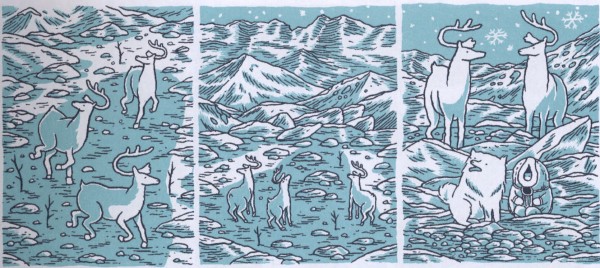 SPURGEON: I don't want to get too deeply into
SPURGEON: I don't want to get too deeply into By This Shall You Know Him
-- or Even The Giants -- but I do wonder about those books, primarily, in terms of the triggering influence or what you were seeing that made you want to do that comic. Was the location of your interest more in the actual creation myths and folk tales of which those books were reminiscent, or were you more interested in some of the oddball ways those have been interpreted through art?
JACOBS: I'm not sure. It feels like such a long time ago and I have trouble recalling where I was at, mentally, when I made those books. While drawing
Even the Giants, and in some sense
BTSYKH, I was trying to figure out how to make comics. I guess I'm still doing that.
SPURGEON: You've said in past interviews that the Safarai Honeymoon
narrative came out of your desire to find a story that encompassed the drawings you were doing that you found interesting. Do the drawings that become a story like that, are they of a type in a way that suggests a story? Do you ever leave certain drawings out as the story develops because they don't fit anymore?
JACOBS: My process is scattered. With
Safari Honeymoon, I got a lot of ideas from sketches. A lot of the scenes were directly informed by doodles I drew. It's kind of like a puzzle, fitting all these elements together, trying to make some kind of narrative out of randomness. As the project progressed, the structure of the story crystallized and the sketching became more directed. I have tons of drawings that were left out of the book.
SPURGEON: Did the characters start as drawings, too? Because I think they're fully-realized in this story, and I'm interested in how you got there. How much work do you on characterization, or is that even a concern distinct from the narrative itself?  Do you worry about things like character arcs and how specific characters move from one place to another?
JACOBS: Thanks. I'm becoming more concerned with character development, and everything that that encompasses. It doesn't come as naturally as drawing, and writing dialogue is the toughest form of writing for me.
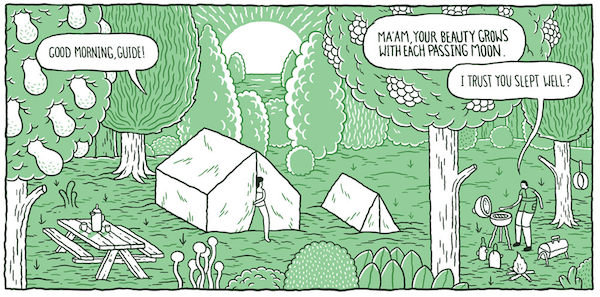 SPURGEON: All three of the main characters are interesting for how each one is a strong example of a really richly-realized stock character, but they also confound expectations as the story progresses. When you work with characters like the Safari Guide, are you aware that you're dealing with a
SPURGEON: All three of the main characters are interesting for how each one is a strong example of a really richly-realized stock character, but they also confound expectations as the story progresses. When you work with characters like the Safari Guide, are you aware that you're dealing with a kind
of character we've seen before, and do you purposefully play against that?
JACOBS: I was conscious of it, but the characters kind of grew organically. I wanted them all to become more than the archetypes their personalities are based upon. I didn't want to allow the female character to become merely a focal point for the male gaze. The audience has expectations about how these characters will behave, and I tried to play with that. Everyone has read characters like them before, so certain behaviors are already established. It's interesting to try to turn them around and change the direction of a character while still maintaining their essence.
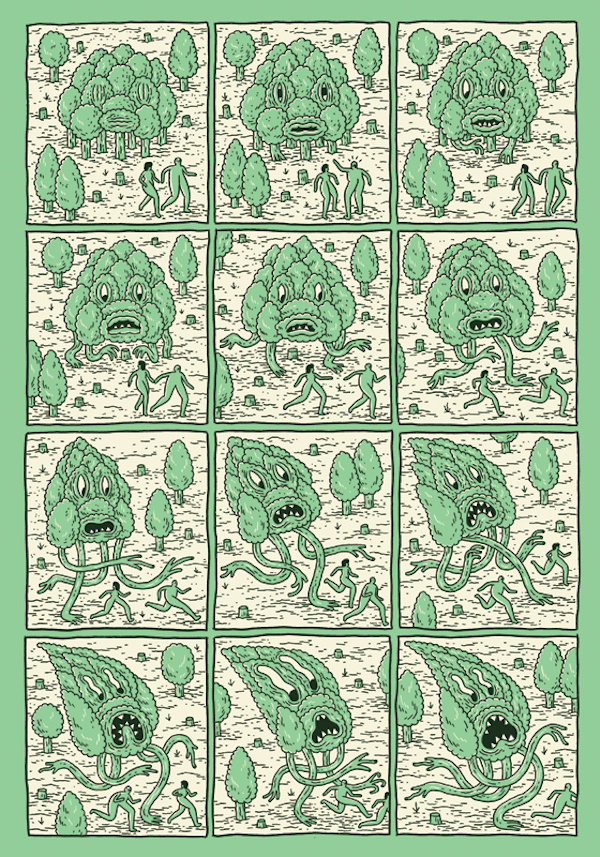 SPURGEON: I know that you have a real love for nature, and while I might be able to take a facile stab at it, I wonder if you could talk for a bit how you want to express the natural world in
SPURGEON: I know that you have a real love for nature, and while I might be able to take a facile stab at it, I wonder if you could talk for a bit how you want to express the natural world in Safari Honeymoon
. There's an exaggeration to the creatures and their danger and the kind of teeming busy-ness of the world you've made that's almost all by itself comedic -- it certainly leads to a heightened awareness of the dangers of that world and where our own is like that. Is there an effect you're hoping for through that depiction in terms of how it comments on our own natural world, or is that something you're willing to let exist on the page without additional comment? Is that how you see the natural world, Jesse?
JACOBS: I believe there are a lot of ways of viewing the natural world, and it's hard for me, who has led a pampered life, to really have any idea of what it's like to actually live in it. I'm so removed from it. It seems pretty rough from watching nature shows, which had a big influence on
Safari Honeymoon. In my day job I work with a lot of farmers, who have a close relationship to the environment, and their lives are very difficult. For what it's worth, I think the natural order of the world is simultaneously beautiful and gruesome. I tried to reflect that in my comic.
 SPURGEON: What do you find funny? This work in particular is really humorous, but I'm not detecting an obvious source, particularly a comics-related one.
SPURGEON: What do you find funny? This work in particular is really humorous, but I'm not detecting an obvious source, particularly a comics-related one.
JACOBS: That's a difficult question. I don't set out to write a funny comic, but throughout the process of making comics I find I am presented with opportunities to try to make jokes. I gravitate towards things that are subtly funny. I think a lot of writers are funny. Off the top of my head I find
David Foster Wallace funny in a unique way,
Jonathan Goldstein's books and radio show/podcast
Wiretap are fantastic. Personally, I find successful funny comics employ a distinct type of humour, sometimes the drawings make an otherwise ordinary scene hilarious. I find
[Michael] Deforge is really funny,
Patrick Kyle as well.
SPURGEON: Your use of language is really interesting in all of your book-published work; is that a comfortable area of creation for you? Because it's at once assured but there are also signs that you're still developing a scripting style that you like. How much time do you spend in Safari Honeymoon
working out the voice of each character, and pruning conversation to their essentials?
JACOBS: As I said earlier, I have the most trouble writing dialogue. I try to make sure I don't have every character speaking in the same voice. I'm much more comfortable writing as a third person narrator, it comes more natural and seems closer to the way I think. I pay close attention to dialogue in novels and films. Throughout the process of making this comic the dialogue was in a constant state of revision.
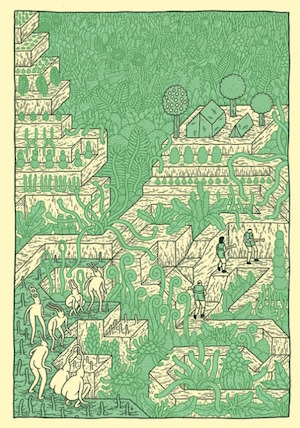 SPURGEON: All three of your books are very attractive; this one is frequently stop and stare beautiful, just the design of it. Can you talk a little bit about your approach to color, and how that serves the story here? How conscious are you at all of time of design choices working within the narrative?
SPURGEON: All three of your books are very attractive; this one is frequently stop and stare beautiful, just the design of it. Can you talk a little bit about your approach to color, and how that serves the story here? How conscious are you at all of time of design choices working within the narrative?
JACOBS: I color all my comics digitally. Digital coloring is overwhelming; there are so many choices. Settling on a simple palette allows me to focus on other things. Because my colour choices are usually very sparse, I try to make sure they are strong. I try to choose colours that enhance the ambience of the story without distracting from it. I put a lot of work into my drawings, and I strive to make colour choices that enhance the line work.
I take a similar approach to choosing grid layouts. I settle on a few simple grids, and focus my energies on drawing and story.
SPURGEON: Do you feel like you have peers? I know I've seen you clustered together with artists like Jesse Moynihan, for example, and even connected back to the Fort Thunder crew. You mentioned Rilly. Do you feel like you have shared interests with any other cartoonists?
JACOBS: I feel a connection to a lot of cartoonists working now.
Jesse Moynihan is one of my favorites, I'm very inspired by his work and how much he does. I think we share a lot of interests. There are so many great artists making comics, and though maybe my work doesn't look like theirs, I think we share a lot of the same sentiments. I really enjoy and feel a connection to artists such as
Olivier Schrauwen,
Aisha Franz, Patrick Kyle. I think what these creators have in common is the uniqueness of each of their voices, which inspires me to do my own thing.
SPURGEON: Has comics been a difficult place for you to work? Has it been rewarding? You've been around more than five years now... do you see yourself continuing to make comics? What's the challenging part of that for you?
JACOBS: I don't struggle with it too much. I have a lot of fun drawing comics. It's an outlet. There are so many distinct elements to making comics, which is what attracts me to it. The variety of tasks involved allows me to be productive. If I don't feel like drawing I can scan and colour pages, or do some writing. There are some very cerebral elements, and a lot of work that involved shutting of your brain and becoming a machine. It's a good balance.
Creating comics has allowed me to meet a lot of wonderful people all over the world. I've been lucky to connect with so many supportive people. I'm working on some new stories now, but also balancing comics with other types of drawing.
*****
*
Jesse Jacobs
*
Jesse Jacobs Tumblr
*
Safari Honeymoon, Jesse Jacobs, Koyama Press, 9781927668047, 80 pages, softcover, May 2014, $15.
*****
* cover to the latest book (top)
* all interior art from Jacobs' books the cold blue is
Even The Giants, the lavender/purple is
By This Shall You Know Him and the green is
Safari Honeymoon; if I did my job, the individual choices are understandable in context
* one last piece of art from
Safari Honeymoon (below)
*****

*****
*****
posted 8:00 pm PST |
Permalink
Daily Blog Archives
November 2019
October 2019
September 2019
August 2019
July 2019
Full Archives


